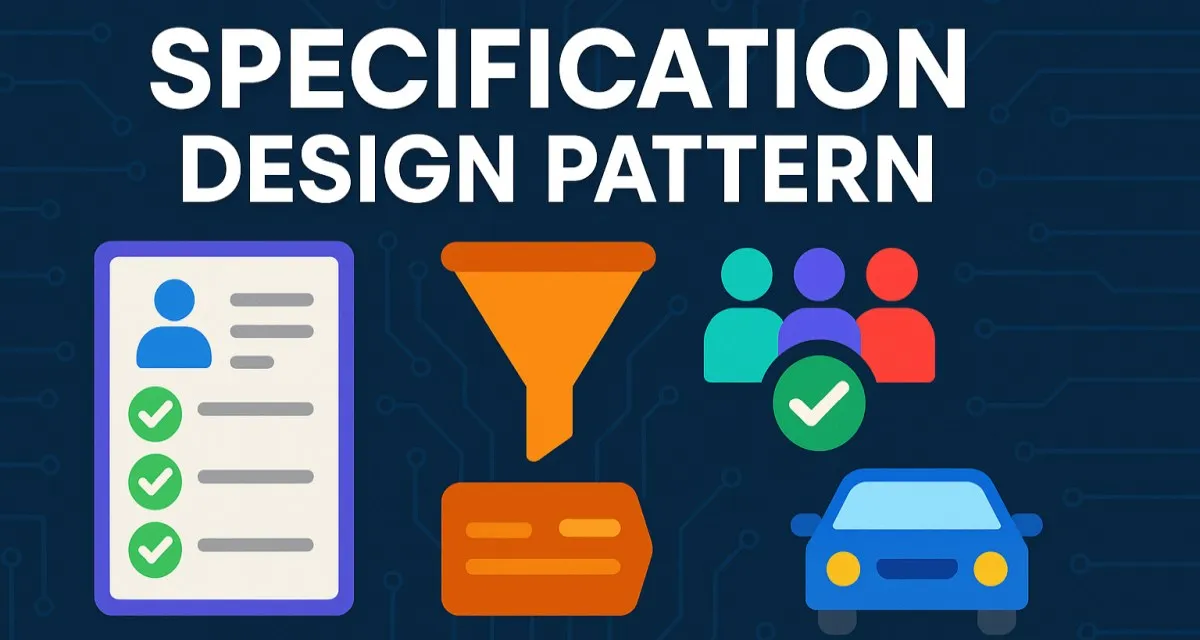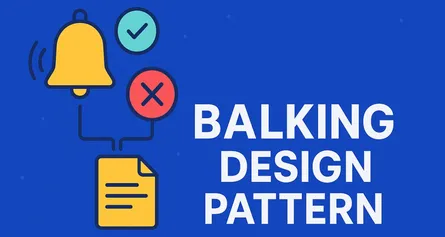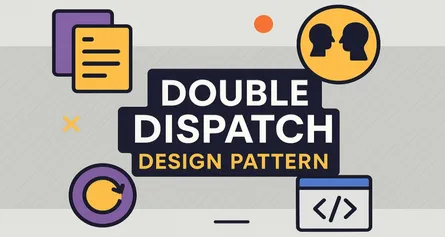
Specification Design Pattern: The Ultimate Guide for Software Architects
What is the Specification Design Pattern?
Imagine you’re a chef…
You’re told, “Only cook meals that are vegetarian, gluten-free, and under 500 calories.”
Sounds like a lot of thinking, right?
Now imagine someone hands you a recipe book — a book where every recipe already meets those requirements.
All you have to do is flip through and pick one.
That’s what the Specification Pattern does for your code!
It lets you encapsulate business rules (like “must be vegetarian, gluten-free, and low-calorie”) into reusable, testable, composable objects.
Instead of hard-coding rules into your methods, you build Specifications — special objects that know how to check if something meets a certain criteria.
In short:
Specification Pattern = a fancy way to ask, “Does this thing meet my rules?” without cluttering your business logic.
Principles Behind the Specification Pattern
Before we build something awesome, let’s understand the deep roots behind it:
1. Encapsulation of Business Rules
You put the rules somewhere separate — not jammed into your services or controllers.
Why care?
When the rules change (and they will), you change just the Specification class, not a hundred different places.
2. Reusability
Build once, reuse everywhere!
One “Vegetarian Specification” could work for recipes, menus, catering services — anything.
3. Composability
Here’s the cool part — you can combine Specifications like LEGO blocks:
- AND two specs together
- OR them
- NOT them
Example:
“Show me all vegetarian AND gluten-free meals, but NOT spicy.”
4. Separation of Concerns
You keep your core logic clean, focused, and sharp.
No one wants a method that’s 200 lines of tangled if-statements, right?
5. Single Responsibility Principle
Each Specification does one job: checking if an object satisfies a rule.
No side effects, no drama.
When Should You Use the Specification Pattern?
Alright, time to get real: you don’t always need a Specification.
Sometimes a simple if-statement will do.
But if you spot these signs, Specification might just be your hero:
Complex Business Rules
If your “Is this thing valid?” checks have turned into a spaghetti mess… use Specifications.
Repeating the Same Conditions Everywhere
If you copy-paste the same logic across 10 services… oops.
You need Specifications.
Combining Lots of Rules
Rules are like toppings on a pizza.
One or two? Cool.
Fifteen? Yikes.
Specifications make combining and stacking rules easy and readable.
Need for Dynamic Queries
Ever had a screen where users can pick their filters?
”Show me all products under $50, that are eco-friendly, and shipped from Canada.”
You can’t hardcode that!
Specifications let you build dynamic filters at runtime.
Key Components of the Specification Pattern
Let’s meet the cast:
| Component | Role |
|---|---|
| ISpecification | Interface that defines the “IsSatisfiedBy” method. |
| Concrete Specification | A class that implements ISpecification and contains a real rule. |
| Composite Specification | Specs that combine other specs using AND, OR, NOT logic. |
| Evaluator (optional) | A helper to apply the specs to collections or queries. |
Detailed C# Implementation
Ready?
Buckle up — we’re going to code the full thing.
Step 1: Define the ISpecification Interface
public interface ISpecification<T>
{
bool IsSatisfiedBy(T entity);
ISpecification<T> And(ISpecification<T> other);
ISpecification<T> Or(ISpecification<T> other);
ISpecification<T> Not();
}Step 2: Create the Base Specification Class
We can implement the combinators here to avoid repeating code.
public abstract class Specification<T> : ISpecification<T>
{
public abstract bool IsSatisfiedBy(T entity);
public ISpecification<T> And(ISpecification<T> other)
{
return new AndSpecification<T>(this, other);
}
public ISpecification<T> Or(ISpecification<T> other)
{
return new OrSpecification<T>(this, other);
}
public ISpecification<T> Not()
{
return new NotSpecification<T>(this);
}
}Step 3: Create Composite Specifications
public class AndSpecification<T> : Specification<T>
{
private readonly ISpecification<T> _left;
private readonly ISpecification<T> _right;
public AndSpecification(ISpecification<T> left, ISpecification<T> right)
{
_left = left;
_right = right;
}
public override bool IsSatisfiedBy(T entity)
{
return _left.IsSatisfiedBy(entity) && _right.IsSatisfiedBy(entity);
}
}
public class OrSpecification<T> : Specification<T>
{
private readonly ISpecification<T> _left;
private readonly ISpecification<T> _right;
public OrSpecification(ISpecification<T> left, ISpecification<T> right)
{
_left = left;
_right = right;
}
public override bool IsSatisfiedBy(T entity)
{
return _left.IsSatisfiedBy(entity) || _right.IsSatisfiedBy(entity);
}
}
public class NotSpecification<T> : Specification<T>
{
private readonly ISpecification<T> _specification;
public NotSpecification(ISpecification<T> specification)
{
_specification = specification;
}
public override bool IsSatisfiedBy(T entity)
{
return !_specification.IsSatisfiedBy(entity);
}
}Step 4: Example: Build Real Specifications
Let’s model a Product and write some specs.
public class Product
{
public string Name { get; set; }
public decimal Price { get; set; }
public bool IsVegetarian { get; set; }
public bool IsGlutenFree { get; set; }
}Concrete Specifications
public class VegetarianSpecification : Specification<Product>
{
public override bool IsSatisfiedBy(Product product)
{
return product.IsVegetarian;
}
}
public class GlutenFreeSpecification : Specification<Product>
{
public override bool IsSatisfiedBy(Product product)
{
return product.IsGlutenFree;
}
}
public class CheapSpecification : Specification<Product>
{
private readonly decimal _maxPrice;
public CheapSpecification(decimal maxPrice)
{
_maxPrice = maxPrice;
}
public override bool IsSatisfiedBy(Product product)
{
return product.Price <= _maxPrice;
}
}Step 5: Putting It All Together
var vegetarianSpec = new VegetarianSpecification();
var glutenFreeSpec = new GlutenFreeSpecification();
var cheapSpec = new CheapSpecification(10m);
// Combo: Vegetarian AND Gluten-Free AND Cheap
var happyCustomerSpec = vegetarianSpec.And(glutenFreeSpec).And(cheapSpec);
var products = new List<Product>
{
new Product { Name = "Veggie Burger", IsVegetarian = true, IsGlutenFree = true, Price = 8 },
new Product { Name = "Chicken Sandwich", IsVegetarian = false, IsGlutenFree = true, Price = 7 },
new Product { Name = "Salad", IsVegetarian = true, IsGlutenFree = true, Price = 12 }
};
var happyProducts = products.Where(p => happyCustomerSpec.IsSatisfiedBy(p));
foreach (var product in happyProducts)
{
Console.WriteLine(product.Name);
}Output:
Veggie BurgerBoom!
You just filtered your list using elegant, flexible business rules!
Different Ways to Implement Specification Pattern (With C# Examples)
Alright, now that you’ve seen the classic way…
Let’s level up — because there’s more than one way to skin this cat (or code this pattern ).
1. Classic OOP-Based Specifications (the way we just did it)
We already did this one:
- Interface + abstract base class
- Each rule in its own class
- Compose them with AND, OR, NOT
Great for solid architecture
Easy to unit test
Very explicit
2. LINQ Expression-Based Specifications (The Superpower Way)
Sometimes, instead of just saying “is this object good?”…
You want to turn the Specification into a database query.
That’s where Expression Trees come in!
We modify our Specification to spit out a Expression<Func<T, bool>>.
Here’s the magic:
using System.Linq.Expressions;
public interface ILinqSpecification<T>
{
Expression<Func<T, bool>> ToExpression();
bool IsSatisfiedBy(T entity);
}The base class:
public abstract class LinqSpecification<T> : ILinqSpecification<T>
{
public abstract Expression<Func<T, bool>> ToExpression();
public bool IsSatisfiedBy(T entity)
{
var predicate = ToExpression().Compile();
return predicate(entity);
}
}Now our specifications generate LINQ!
Example:
public class CheapProductSpecification : LinqSpecification<Product>
{
private readonly decimal _maxPrice;
public CheapProductSpecification(decimal maxPrice)
{
_maxPrice = maxPrice;
}
public override Expression<Func<Product, bool>> ToExpression()
{
return product => product.Price <= _maxPrice;
}
}Usage:
var cheapSpec = new CheapProductSpecification(10m);
// In-memory filter
var cheapProducts = products.Where(cheapSpec.IsSatisfiedBy);
// Or DB query
var cheapProductsFromDb = dbContext.Products.Where(cheapSpec.ToExpression());Boom.
Your specs now work both in-memory and in Entity Framework Core queries.
Use Cases: Where Specification Pattern Shines
Wondering where you’ll actually use this stuff?
Here are real-world hotspots:
E-commerce Filters
- “Show all shoes under $100 that are red and size 10.”
- Users stack filters dynamically.
️ Domain-Driven Design (DDD)
Specifications are first-class citizens in DDD.
They live in your domain layer to express complex business rules — clean and decoupled.
Rule Engines
Specifications can be plugged into rule engines to build decision trees or workflow engines.
Search Engines
Any place you need to filter, validate, or query dynamically based on lots of criteria.
Anti-Patterns to Avoid
Hey, even the best tools can cause trouble if you’re careless.
Here are common mistakes people make with Specifications:
God Specification
One spec trying to do everything:
Instead of combining small specs like “IsAdult” and “IsEmployed,” people shove 20 conditions into one class.
Fix it:
Keep your Specifications small and single-responsibility.
No Reuse
If you write the same check in 5 different Specifications…
You’re defeating the entire purpose.
Fix it:
Compose small specs with AND, OR, NOT — don’t repeat.
Overengineering
If your project only has one simple rule… maybe you don’t need Specifications at all.
Don’t build a castle when you just need a tent.
Fix it:
Use it when complexity justifies it, not because it’s trendy.
Advantages of the Specification Pattern
Why would you bother building all this, anyway?
Glad you asked:
| Advantage | Why It Matters |
|---|---|
| Reusability | Write once, use everywhere. |
| Composability | Combine rules like LEGOs. |
| Readability | Code reads like English. |
| Unit Testability | Specs are dead simple to test. |
| Separation of Concerns | Business rules don’t pollute services. |
| Dynamic Queries | Build queries at runtime with LINQ! |
Disadvantages of the Specification Pattern
Yeah, nothing’s perfect.
Here’s what you need to watch out for:
| Disadvantage | What Happens |
|---|---|
| Boilerplate | A lot of small classes if not managed properly. |
| Overhead | Might feel heavy for very simple scenarios. |
| Expression Complexity | Building combined LINQ expressions can get tricky. |
| Debugging Pain | Deep nested specifications might confuse new devs. |
More Anti-Patterns to Watch Out For
Yep, a few more to stay sharp:
Hardcoding Data Access
Don’t let your Specifications hit the database themselves!
Specifications describe rules, they don’t fetch the data.
Ignoring Composition
Always building one big Specification instead of composing smaller ones makes your system rigid and ugly.
No Unit Testing
If you don’t test your Specifications, you’re inviting bugs in your business logic.
Unit tests should be simple:
[Test]
public void Should_Return_True_When_Product_Is_Vegetarian()
{
var spec = new VegetarianSpecification();
var product = new Product { IsVegetarian = true };
Assert.IsTrue(spec.IsSatisfiedBy(product));
}Conclusion: Why Every Serious Architect Should Know Specification Pattern
Let’s wrap it up:
The Specification Pattern isn’t just some fancy academic idea.
It’s a real-world, battle-tested weapon for any serious Software Architect building complex, evolving, dynamic systems.
It helps you:
Keep code clean and dry
Reuse rules everywhere
Combine conditions easily
Build dynamic filters for anything
Sleep better at night (trust me)
When should you use it?
When your business rules start looking like a ball of spaghetti.
When should you skip it?
When a simple if will do, don’t overcomplicate things.
Share this article
Help others discover this content
About Sudhir mangla
Content creator and writer passionate about sharing knowledge and insights.
View all articles by Sudhir mangla →




